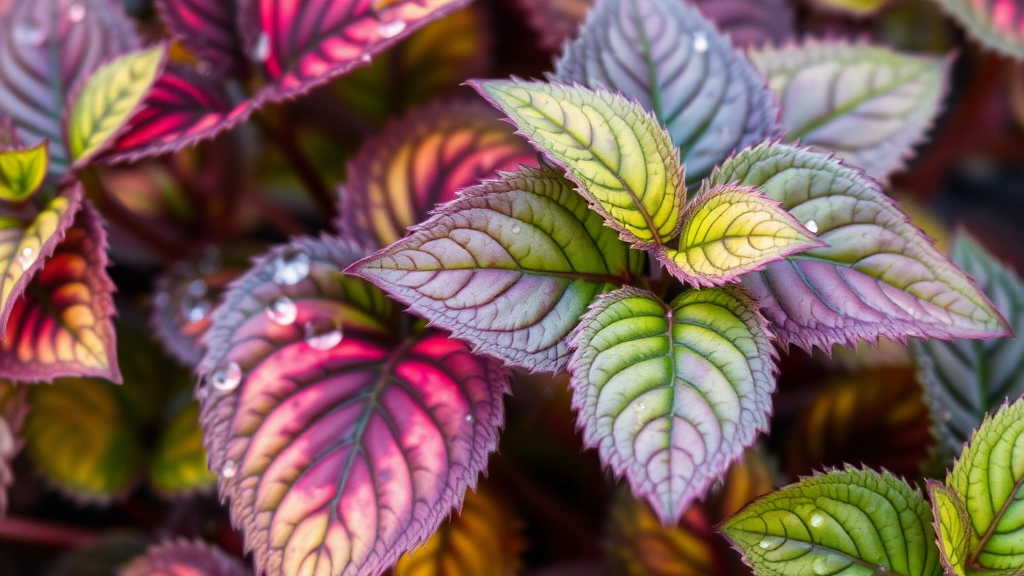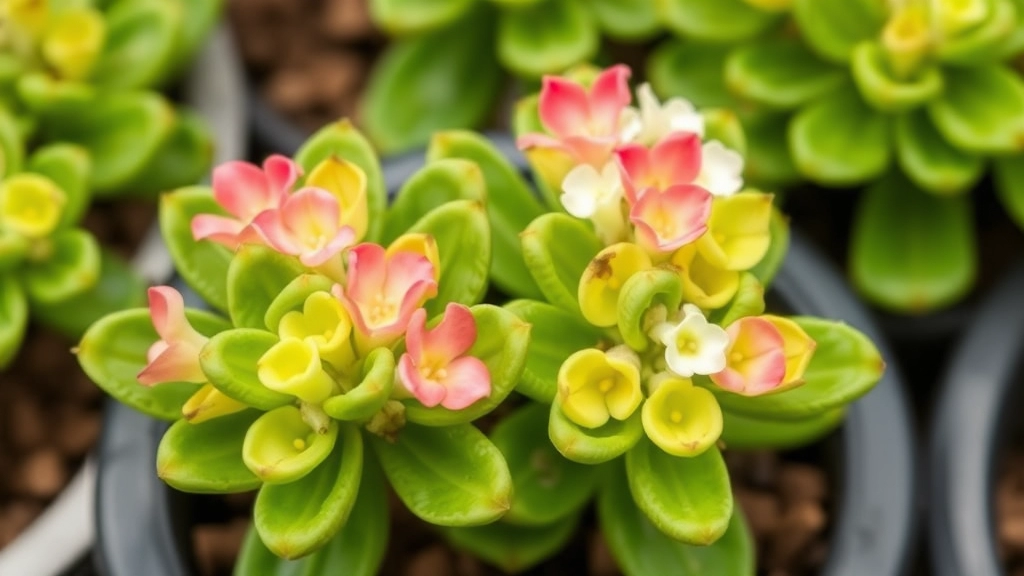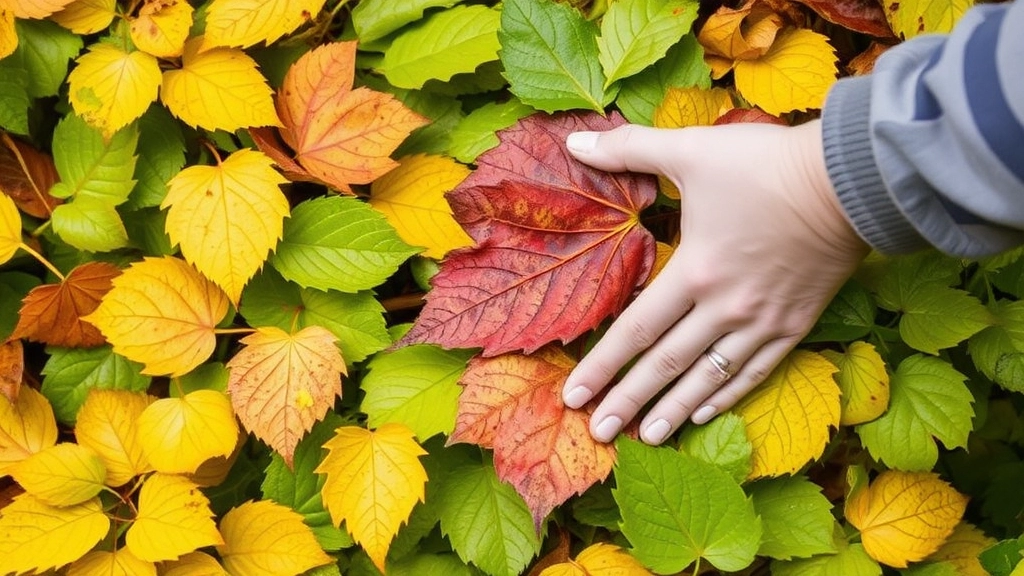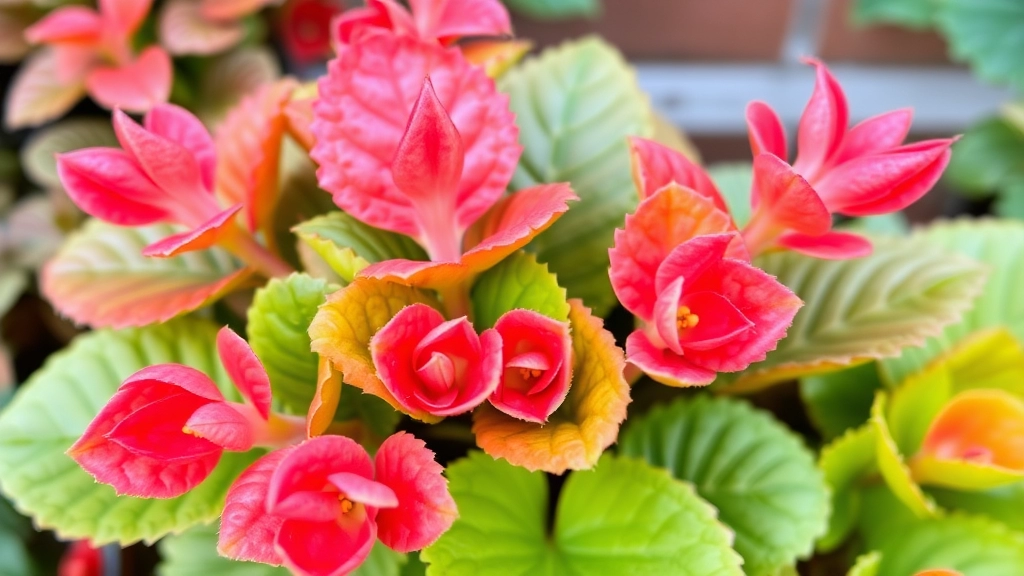Kalanchoe Leaf Color Changes
Noticing your Kalanchoe leaves turning red can be quite alarming. This change in colour is often a sign that something isn’t right with your plant. Understanding the common causes can help you address the issue and restore your Kalanchoe to its vibrant green state.
Common Causes of Red Leaves
Excess sunlight is a primary culprit. Kalanchoe plants thrive in bright but indirect light. If exposed to too much direct sunlight, their leaves may turn red as a stress response. Additionally, soil quality, watering habits, and temperature fluctuations can all impact leaf colour, making it crucial to maintain optimal care conditions.
Have you noticed your Kalanchoe leaves turning red? This change in colour can be concerning for many plant enthusiasts.
Understanding the common causes of Kalanchoe leaves turning red is crucial for effective care.
### 1. Excess Sunlight
Kalanchoe plants thrive in bright light, but too much direct sunlight can lead to stress.
– **Signs of Sunburn:** Leaves may develop a reddish hue as a protective response.
– **Solution:** If your plant is in direct sunlight for extended periods, consider relocating it to a spot with filtered light.
### 2. Soil Quality
The soil you use can significantly impact your Kalanchoe’s health.
– **Nutrient Deficiency:** Poor soil can lead to insufficient nutrients, causing leaves to change colour.
– **Solution:** Use well-draining soil enriched with organic matter to promote healthy growth.
### 3. Watering Issues
Both overwatering and underwatering can cause leaf discoloration.
– **Overwatering:** This can lead to root rot, causing leaves to turn red and eventually drop.
– **Underwatering:** Insufficient moisture can stress the plant, leading to red leaves.
– **Solution:** Ensure a consistent watering schedule, allowing the soil to dry out between waterings.
### 4. Temperature Fluctuations
Kalanchoe plants prefer stable temperatures.
– **Stress from Cold:** Sudden drops in temperature can shock the plant, resulting in red leaves.
– **Solution:** Keep your plant in a temperature range of 15-25°C (59-77°F) for optimal health.
### 5. Over-Fertilization
While nutrients are essential, too much fertiliser can be harmful.
– **Toxic Build-Up:** Excess nutrients can lead to leaf burn, causing a reddish tint.
– **Solution:** Fertilise sparingly, following the instructions on the fertiliser package.
### 6. Pest Infestation
Certain pests can cause stress and discoloration in Kalanchoe leaves.
– **Common Pests:** Aphids and spider mites are notorious for causing damage.
– **Solution:** Regularly inspect your plant and apply insecticidal soap if needed.
For more detailed care tips, check out our [Complete Care Guide for Kalanchoe Beharensis Variegated](https://planthq.org/complete-care-guide-for-kalanchoe-beharensis-variegated/) and learn how to manage common issues with [Drooping Kalanchoe Leaves](https://planthq.org/how-to-fix-drooping-kalanchoe-leaves-causes-and-solutions/).
Impact of Excess Sunlight on Leaf Color

Have you ever noticed your Kalanchoe leaves turning a vibrant red? It’s not just for show; it could be a sign of too much sunlight.
Kalanchoes are tough little plants, but they can be sensitive when it comes to light exposure.
Here’s how excess sunlight affects their leaf color:
- Sunburned Leaves: Just like our skin, Kalanchoe leaves can get sunburned. This leads to those sun-kissed red tones, which can eventually turn brown and crispy if the plant doesn’t get a break.
- Stress Response: When these plants are exposed to intense sunlight for too long, they might turn red as a stress response. It’s their way of saying, “Hey, I need some shade!”
- Photosynthesis Changes: Too much sun can mess with their ability to photosynthesize properly. This can lead to stunted growth and a shift in leaf colour.
What to Do:
- Relocate Your Plant: If your Kalanchoe is in direct sunlight for hours on end, consider moving it to a spot with filtered light or partial shade.
- Monitor Sun Exposure: Keep an eye on how much sunlight your plant gets throughout the day. A few hours of direct sun in the morning can be great, but too much in the afternoon can be harmful.
- Rotate Regularly: If possible, rotate your plant every few weeks so all sides get equal light exposure. This helps prevent uneven colour changes.
How Soil Quality Affects Kalanchoe Leaves
Have you ever noticed your Kalanchoe leaves changing colour and wondered if it’s due to the soil they’re in?
Soil quality plays a crucial role in the health of your Kalanchoe plants.
If the soil is too compact or lacks essential nutrients, it can lead to stress, causing leaves to turn red or even drop.
Here’s how soil quality impacts Kalanchoe leaves:
- Drainage: Kalanchoe plants thrive in well-draining soil. If water accumulates, it can lead to root rot, affecting leaf health.
- Nutrient Content: A nutrient-deficient soil can hinder growth. Kalanchoe needs a balanced mix of nitrogen, phosphorus, and potassium to maintain vibrant leaves.
- pH Levels: The ideal pH for Kalanchoe is slightly acidic to neutral (around 6.0 to 7.0). If the soil is too alkaline or acidic, it can affect nutrient absorption.
- Organic Matter: Incorporating organic matter like compost can enhance soil quality, improving moisture retention and nutrient availability.
To ensure your Kalanchoe thrives, consider using a cactus or succulent mix, which is designed for optimal drainage and nutrient balance. For more detailed care tips, check out our Kalanchoe Beharensis care guide and our comprehensive Kalanchoe species list for gardeners.
Watering Issues and Leaf Discoloration

Have you ever noticed your Kalanchoe leaves changing colour and wondered if it’s due to improper watering?
Watering issues can significantly affect the health and appearance of your Kalanchoe plants.
Signs of Overwatering
- Soft, Mushy Leaves: If your leaves feel squishy, it’s a clear sign of overwatering.
- Yellowing Leaves: This is often the first indication that roots are suffocating.
- Root Rot: A pungent smell from the soil can indicate severe root rot.
Signs of Underwatering
- Crispy, Dry Edges: If the edges of your leaves are brown and crispy, your plant is likely thirsty.
- Wrinkled Leaves: A lack of moisture can cause leaves to shrivel.
Best Practices for Watering Kalanchoe
- Check Soil Moisture: Always check the top inch of soil before watering.
- Water Thoroughly: When you do water, ensure it’s enough to saturate the soil, but allow excess to drain out.
- Frequency: Water every 2-3 weeks, depending on the season and humidity levels.
The Importance of Drainage
- Well-Draining Soil: Use a cactus or succulent mix to prevent water retention.
- Drainage Holes: Ensure your pot has adequate drainage holes to allow excess water to escape.
Role of Temperature Fluctuations in Leaf Stress
Have you ever noticed your Kalanchoe leaves changing colour, and wondered if temperature might be a factor?
Temperature fluctuations can significantly impact the health of your Kalanchoe plants.
When exposed to extreme temperature changes, Kalanchoe leaves may undergo stress, leading to discolouration or even damage.
Key Temperature Factors to Consider:
- Rapid Changes: Sudden shifts in temperature can shock the plant, causing leaves to turn red or brown.
- Ideal Range: Kalanchoe thrives in temperatures between 20°C and 25°C. Anything below 10°C can be detrimental.
- Heat Stress: Excessive heat, especially above 30°C, can lead to wilting and leaf discoloration.
- Cold Drafts: Exposure to cold drafts or frost can also result in leaf stress, leading to unwanted colour changes.
To mitigate these issues, it’s crucial to place your Kalanchoe in a stable environment, away from direct heat sources or cold drafts.
Tips for Maintaining Optimal Temperature:
- Location Matters: Keep your plants in a spot with consistent temperatures.
- Avoid Windows in Winter: If your Kalanchoe is near a window, ensure it’s not exposed to cold air during winter months.
- Monitor Heat Sources: Keep an eye on radiators or heaters that might cause sudden temperature spikes.
For more detailed guidance on Kalanchoe care, check out our Kalanchoe Pinnata side effects and safety precautions and our tips for maximizing the longevity of your Kalanchoe plant.
Effects of Over-Fertilization on Kalanchoe Plants

Ever wondered why your Kalanchoe leaves are looking a bit off? It might not just be sunlight or water issues. Over-fertilization is a sneaky culprit that can lead to some serious leaf discoloration.
When we think about fertilizing our plants, we often assume more is better. But that’s not always the case. Too much fertilizer can cause nutrient burn, leading to those vibrant leaves turning a sad shade of red or even brown.
Here’s what you need to know about the effects of over-fertilization:
- Nutrient Imbalance: Excess nutrients can upset the balance, making it hard for the plant to absorb what it really needs.
- Leaf Burn: The tips of the leaves may scorch, giving them a crispy, brown edge.
- Stunted Growth: Over-fertilized plants might stop growing altogether, as they’re too busy dealing with the excess.
- Root Damage: High levels of salts from fertilizers can harm the roots, leading to poor water absorption.
I remember when I first started with Kalanchoe. I was so eager to see them thrive that I went a bit overboard with the fertiliser. The leaves turned a shocking red, and I panicked! A quick cut back on the feed and some good watering sorted them out, but it was a learning curve.
To avoid this pitfall, consider these tips:
- Follow Instructions: Always stick to the recommended dosage on the fertiliser label.
- Use Slow-Release Fertilizers: These can provide nutrients over time without overwhelming your plant.
- Monitor Your Plants: Keep an eye on their growth and adjust fertilization as needed.
As we explore the various factors affecting Kalanchoe leaves, it’s essential to consider the role of pests in causing discoloration.
Many plant owners worry about their Kalanchoe turning red or developing unusual spots.
Pests can be sneaky little troublemakers, often hiding under leaves or in the soil.
Here’s a quick guide to some common pests that might be causing your Kalanchoe distress:
– **Mealybugs:** These small, white, cottony insects tend to cluster on stems and leaf joints. They suck the sap from the plant, leading to yellowing and red leaves.
– **Spider Mites:** Tiny and often invisible to the naked eye, spider mites create fine webs on the plant. They thrive in dry conditions and can cause significant leaf discoloration.
– **Aphids:** These green or black insects feed on plant sap and can lead to curling leaves and discoloration.
– **Scale Insects:** Ranging from brown to white, scale insects attach themselves to leaves and stems, draining the plant’s nutrients.
To identify these pests, regularly inspect your Kalanchoe:
– Look for visible insects on the leaves and stems.
– Check for webbing or sticky residue on the leaves, which can indicate spider mites or aphids.
– Gently wipe the leaves with a damp cloth to see if any pests come off.
Once you’ve identified the pests, you can take action to protect your plant. For more detailed advice on dealing with common issues, check out our [guide on causes and solutions for black spots on Kalanchoe leaves](https://planthq.org/causes-and-solutions-for-black-spots-on-kalanchoe-leaves/). Additionally, understanding [how to fix drooping Kalanchoe leaves](https://planthq.org/how-to-fix-drooping-kalanchoe-leaves-causes-and-solutions/) can help you keep your plants healthy and vibrant.
Preventing Further Leaf Damage Through Proper Care

So, you’ve noticed those Kalanchoe leaves turning red, and it’s got you worried, right?
Let’s chat about how to keep your plant healthy and prevent any more leaf damage.
1. Monitor Sunlight Exposure
- Indirect Light: Kalanchoes thrive in bright, indirect sunlight. Too much direct sun can scorch those lovely leaves.
- Rotate Your Plant: Give every side a chance to soak up light evenly.
2. Check Soil Quality
- Well-Draining Soil: Use a cactus or succulent mix to ensure good drainage.
- pH Balance: Aim for a slightly acidic to neutral pH (around 6.0 to 7.0).
3. Water Wisely
- Watering Schedule: Allow the top inch of soil to dry out before watering again.
- Drainage: Make sure your pot has drainage holes to prevent root rot.
4. Keep an Eye on Temperature
- Stable Environment: Kalanchoes prefer temperatures between 15°C and 25°C. Avoid sudden drafts.
- Avoid Frost: These plants are not frost-tolerant, so bring them indoors when it’s chilly.
5. Fertilize Sparingly
- Balanced Fertilizer: Use a diluted, balanced fertilizer during the growing season, but don’t overdo it.
- Frequency: Fertilize once a month during spring and summer.
6. Inspect for Pests
- Regular Checks: Look for any signs of pests like mealybugs or aphids.
- Natural Remedies: Use insecticidal soap or neem oil if you spot any unwelcome guests.
Steps to Restore Kalanchoe Leaves to Their Natural Color
If you’ve noticed your Kalanchoe leaves turning red, you might be wondering how to bring them back to their vibrant green state.
Assess Current Conditions
- Check Sunlight Exposure
Gradually reduce direct sunlight exposure.
Move the plant to a location with bright, indirect light. - Evaluate Soil Quality
Ensure the soil is well-draining.
Consider repotting with a succulent-specific mix if necessary.
Watering Techniques
- Adjust Watering Schedule
Water only when the top inch of soil is dry.
Avoid letting the plant sit in water to prevent root rot.
Temperature Control
- Maintain Stable Temperatures
Keep the plant in an environment between 18-24°C.
Avoid placing it near drafts or heating vents.
Fertilization Practices
- Limit Fertilizer Use
If you’ve over-fertilised, refrain from using fertiliser for a while.
When you do fertilise, opt for a diluted, balanced fertiliser during the growing season.
Pest Management
- Inspect for Pests
Regularly check the undersides of leaves for pests like aphids or mealybugs.
If found, treat with insecticidal soap or neem oil.
Monitor Progress
- Be Patient
Restoration takes time; monitor your plant’s progress.
Adjust care as needed based on its response.
For more detailed care tips, you might want to check out our guide on scalloped Kalanchoe succulents or learn how to fix drooping Kalanchoe leaves to ensure your plant thrives.
FAQs About Kalanchoe Leaves Turning Red
Why are my Kalanchoe leaves turning red?
Kalanchoe leaves turning red can be a sign of too much sunlight. This can cause sunburned leaves, stress responses, and changes in photosynthesis.
How does excess sunlight affect Kalanchoe leaves?
Excess sunlight can lead to sunburned leaves, causing them to turn red. It can also stress the plant, prompting a color change as a response, and disrupt photosynthesis, leading to stunted growth and discoloration.
What should I do if my Kalanchoe is getting too much sunlight?
Consider relocating your plant to a spot with filtered light or partial shade. Monitor its sun exposure and rotate the plant regularly to ensure even light distribution.
Can watering issues cause discoloration in Kalanchoe leaves?
Yes, improper watering can lead to leaf discoloration. Overwatering can cause soft, mushy leaves, yellowing, and root rot, while underwatering can result in crispy, dry edges and wrinkled leaves.
What are the signs of overwatering and underwatering in Kalanchoe plants?
Overwatering signs include soft, mushy leaves, yellowing leaves, and root rot. Underwatering signs include crispy, dry edges, and wrinkled leaves.
How should I water my Kalanchoe plant?
Check the top inch of soil before watering. Water thoroughly but allow excess to drain out. Typically, watering every 2-3 weeks is sufficient, depending on the season and humidity levels.
Why is drainage important for Kalanchoe plants?
Well-draining soil and adequate drainage holes in the pot are crucial to prevent water retention and root rot.
Can over-fertilization cause Kalanchoe leaves to turn red?
Yes, over-fertilization can lead to nutrient burn, causing leaf discoloration, including red or brown shades. It can also result in nutrient imbalance, leaf burn, stunted growth, and root damage.
How can I avoid over-fertilizing my Kalanchoe?
Follow the recommended dosage on the fertilizer label, use slow-release fertilizers, and monitor your plants to adjust fertilization as needed.
What are the best practices to prevent further leaf damage in Kalanchoe plants?
Monitor sunlight exposure, use well-draining soil, water wisely, maintain a stable temperature, fertilize sparingly, and inspect for pests regularly.
What kind of soil is best for Kalanchoe plants?
Use a cactus or succulent mix to ensure good drainage. Aim for a slightly acidic to neutral pH (around 6.0 to 7.0).
How can I ensure my Kalanchoe gets the right amount of sunlight?
Kalanchoes thrive in bright, indirect sunlight. Rotate your plant to give every side equal light exposure and avoid direct sun that can scorch the leaves.
What temperature range is ideal for Kalanchoe plants?
Kalanchoes prefer temperatures between 15°C and 25°C. Avoid sudden drafts and bring them indoors if there’s a risk of frost.
How often should I fertilize my Kalanchoe plant?
Fertilize once a month during the growing season (spring and summer) using a diluted, balanced fertilizer.
What should I do if I find pests on my Kalanchoe?
Regularly check for pests like mealybugs or aphids. Use insecticidal soap or neem oil to treat any infestations.
References
-
Why Are My Kalanchoe Leaves Turning Red?
-
How to Care for Kalanchoe Plants
-
Kalanchoe: How to Grow and Care for Kalanchoe Plants
